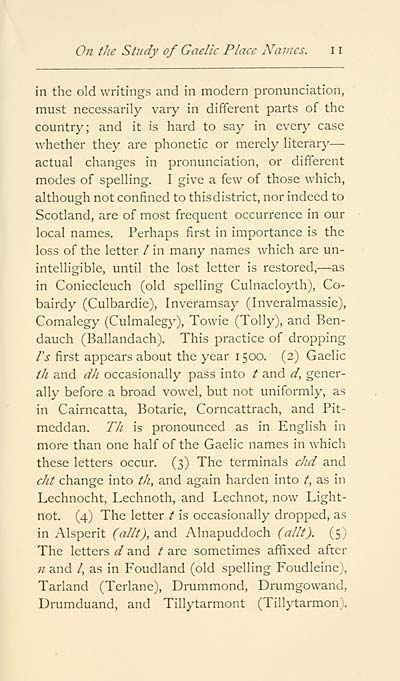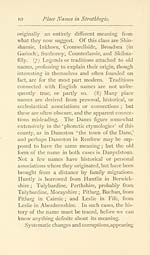Blair Collection > Place names in Strathbogie, with notes historical, antiquarian and descriptive
(31)
Download files
Complete book:
Individual page:
Thumbnail gallery: Grid view | List view

On the Study of Gaelic Place Najucs. 1 1
in the old writings and in modern pronunciation,
must necessarily vary in different parts of the
country; and it is hard to say in ever}' case
whether they are phonetic or merely literary —
actual changes in pronunciation, or different
modes of spelling. I give a few of those which,
although not confined to thisdistrict, nor indeed to
Scotland, are of most frequent occurrence in our
local names. Perhaps first in importance is the
loss of the letter / in many names which are un-
intelligible, until the lost letter is restored, — as
in Coniecleuch (old spelling Culnacloj'th), Co-
bairdy (Culbardie), Inveramsay (Inveralmassie),
Comalegy (Culmalegy), Towie (Tolly), and Ben-
dauch (Ballandach). This practice of dropping
I's first appears about the year 1500. (2) Gaelic
tli and dh occasionally pass into / and d, gener-
ally before a broad vowel, but not uniformly, as
in Cairncatta, Botarie, Corncattrach, and Pit-
meddan. Th is pronounced as in English in
more than one half of the Gaelic names in which
these letters occur. (3) The terminals c/id and
cht change into th, and again harden into t, as in
Lechnocht, Lechnoth, and Lechnot, now Light-
not. (4) The letter t is occasionally dropped, as
in Alsperit (alit), and Alnapuddoch (allt). (5)
The letters d and t are sometimes affixed after
n and /, as in Foudland (old spelling Foudleine),
Tarland (Terlane), Drummond, Drumgowand,
Drumduand, and Tillytarmont (Tillytarmon).
in the old writings and in modern pronunciation,
must necessarily vary in different parts of the
country; and it is hard to say in ever}' case
whether they are phonetic or merely literary —
actual changes in pronunciation, or different
modes of spelling. I give a few of those which,
although not confined to thisdistrict, nor indeed to
Scotland, are of most frequent occurrence in our
local names. Perhaps first in importance is the
loss of the letter / in many names which are un-
intelligible, until the lost letter is restored, — as
in Coniecleuch (old spelling Culnacloj'th), Co-
bairdy (Culbardie), Inveramsay (Inveralmassie),
Comalegy (Culmalegy), Towie (Tolly), and Ben-
dauch (Ballandach). This practice of dropping
I's first appears about the year 1500. (2) Gaelic
tli and dh occasionally pass into / and d, gener-
ally before a broad vowel, but not uniformly, as
in Cairncatta, Botarie, Corncattrach, and Pit-
meddan. Th is pronounced as in English in
more than one half of the Gaelic names in which
these letters occur. (3) The terminals c/id and
cht change into th, and again harden into t, as in
Lechnocht, Lechnoth, and Lechnot, now Light-
not. (4) The letter t is occasionally dropped, as
in Alsperit (alit), and Alnapuddoch (allt). (5)
The letters d and t are sometimes affixed after
n and /, as in Foudland (old spelling Foudleine),
Tarland (Terlane), Drummond, Drumgowand,
Drumduand, and Tillytarmont (Tillytarmon).
Set display mode to: Large image | Transcription
Images and transcriptions on this page, including medium image downloads, may be used under the Creative Commons Attribution 4.0 International Licence unless otherwise stated. ![]()
| Early Gaelic Book Collections > Blair Collection > Place names in Strathbogie, with notes historical, antiquarian and descriptive > (31) |
|---|
| Permanent URL | https://digital.nls.uk/81166718 |
|---|
| Description | A selection of books from a collection of more than 500 titles, mostly on religious and literary topics. Also includes some material dealing with other Celtic languages and societies. Collection created towards the end of the 19th century by Lady Evelyn Stewart Murray. |
|---|
| Description | Selected items from five 'Special and Named Printed Collections'. Includes books in Gaelic and other Celtic languages, works about the Gaels, their languages, literature, culture and history. |
|---|

